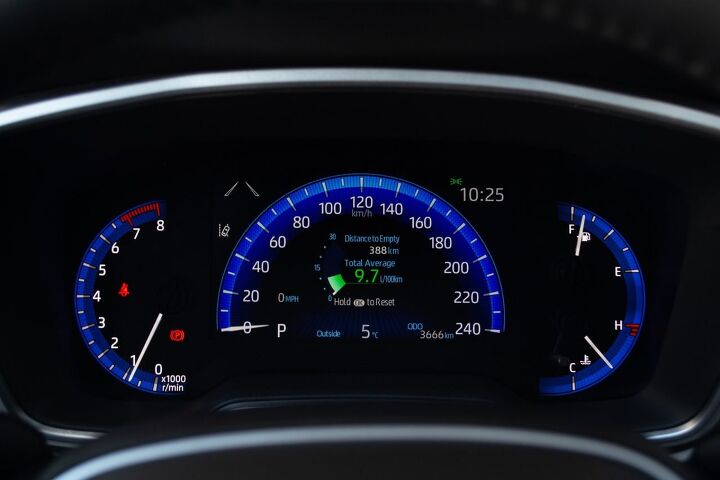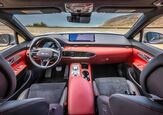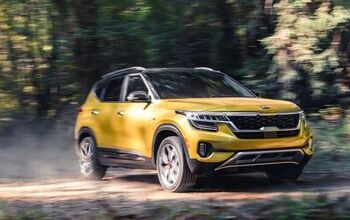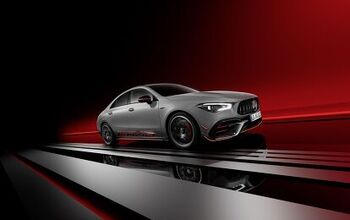Toyota Corolla Cross Vs Kia Seltos Comparison

The sub-compact crossover segment is the fastest-growing in North America.
Everyone wants a piece of the pie, like the four-wheeled equivalent of the gold rush 170 years ago. As supposedly “compact” crossovers become larger than grampa’s Buick, the class below has room to grow, in both dimension and sales figures. The 2022 Toyota Corolla Cross is a shining example: this new model is almost 10 inches longer than big brother RAV4 was in 2005. Similarly, Kia has the Seltos, which showed up on the scene last year. It’s less than an inch bigger than a Sportage of the same vintage.
Get a Quote on a New Toyota Corolla Cross or Kia SeltosNobody would have accused either of those older models of being too small. So are the Corolla Cross and Seltos all the car most people need? And has either one of these manufacturers struck gold? We spent a week with them both to find out.
Interior and Cargo Space
Corolla Cross: Toyota isn’t just sticking the Corolla name on its latest crossover to bank on its 50-million-sold reputation. Inside, you’d be hard-pressed to tell you aren’t in the stalwart sedan. There’s a lot of clear dashboard space, though this tester’s light texture makes it all feel airier. The layout makes it super-simple to get acquainted with all the important controls in seconds. Toyota has tweaked the space ahead of the shifter, with a much clearer USB port setup and an available wireless charger. Material quality is good, and there’s a reasonable amount of storage in the door cards.
While they’re mounted higher, the seats look largely like the thrones in three-box Corolla. They’re different under the skin though, with changes to support the more upright driving nature here. Whatever Toyota’s done, they’re comfy, easily keeping us complaint-free on the longer drives the holiday season requires.
Toyota might sell the Corolla Cross as the more capacious offering over the C-HR, but it isn’t quite so clear-cut. Legroom is 42.9 inches up front and 32.0 inches in the back (1,090 and 813 millimeters). The C-HR posts 43.5 and 31.7 inches (1,104 and 805 mm), respectively. The CC’s got about an inch of extra headroom though, measuring in at 39.5 and 39.1 inches (1,003 and 993 mm) front to back. It’s a narrow space too, so maybe only stick three adults back there if they’re good friends.
Popping the trunk reveals 25.2 cubic feet (714 L) of storage—slightly less than the front-drive models. Toyota doesn’t quote a number for the seats down. The load lip is helpfully low, and the power tailgate is a welcome touch. Towing capacity is capped at 1,500 lb.
Seltos: If the CC is all about keeping design simple, the Seltos is the opposite. Its center stack is much busier, but mostly because the controls are spaced out. It’s a sober layout, though we wouldn’t say no to some lighter material choices. On that note, the plastic inside the Seltos is certainly a step down in quality versus the Toyota, especially lower down on the center console, and the door panels.
We really dig the plum-colored synthetic leather seats in the Seltos. They’re comfortable and more supportive than the flatter perches in the CC. Front-seat passengers also get power adjustability, which is far from a given in the class.
Even if it looks boxier, the Kia gives up around an inch of headroom to the Toyota, coming in at 38.4 and 38.3 inches (977 and 975 mm) front and back. Leg room is 41.3 inches (1,051 mm) up front—fine, if less than the CC—but a huge 38.0 inches (965 mm) in the rear. With the extra couple inches of width that the Seltos enjoys over the Corolla Cross, it’s a much friendlier second-row experience for adults and kids alike. Installing a car seat shouldn’t be an issue in either car.
Another deceptive measurement: trunk space. The Seltos edges out the Corolla, with 26.5 cubic feet (752 L) with seats up. Drop ’em for 62.8 cu-ft (1,778 L). The tailgate opening is nice and square, too. We just wish there was a powered option. Kia doesn’t officially quote a towing capacity for the Seltos.
SEE ALSO: Subaru Crosstrek vs Mazda CX-30 ComparisonBottom Line: The Kia scores a decisive first win here, with an interior that does more to impress. Even if its material quality is inconsistent, the Seltos’ interior is brimming with enough features to dispel any “economy car” disparagement.
Tech and Features
Corolla Cross: Despite launching for this year, the Corolla Cross arrives with Toyota’s old Entune infotainment system. It’s small (8.0 inches), and only moderately quick in its responses. Wired Apple CarPlay and Android Auto are standard on all trims, and higher ones drop in a wireless charger for good measure. If there’s a nice thing we can say about Entune, it’s that the physical buttons make it easier to operate on touch alone.
The instrument panel uses a combination of analog dials sandwiching a digital screen. It works well, allowing the driver to easily swap between relevant info, all clearly visible. It’s a fool-proof system. We dig the blue hue, too.
Dual-zone climate control works quickly on cold winter mornings. Nevermind that: the heated steering wheel got positively blazing in no time—easily the most effective one I’ve tested in the last year. Props, Toyota Canada, for knowing your market. On the other hand, the JBL sound system is merely okay. Toyota’s still using a backup camera seemingly pilfered from an old Nokia cellphone, too.
Seltos: Kia’s 10.25-inch touchscreen certainly makes a stronger first impression, with cool purple hues and a modern typeface. The latter isn’t great for legibility though, so it can be tough to read at a glance or at nighttime. Unlike a certain corporate sibling, Kia hasn’t dropped the physical volume knob either, so that’s a positive. The system is a little sluggish though, especially at startup.
Similar to the Corolla, the Seltos uses a combo of analog and digital for its instrument cluster. It’s less flashy, but it’s hard to fault the classic white on black. There’s also a useful head-up display ahead of the wheel. It’s the less desirable pop-up glass style, but there’s enough adjustability to account for most drivers.
The Kia makes do with single-zone automatic climate control, a surprising concession. The system works well enough, however, as do the seat and wheel heaters—the latter nothing like the Corolla Cross, though. Similarly, while it has a power-adjustable passenger seat (the Corolla’s is fully manual), the Seltos doesn’t offer a powered tailgate at all.
SEE ALSO: 2021 Kia Seltos vs 2020 Mazda CX-3 vs 2020 Toyota C-HR ComparisonBottom Line: That’s another notch in the Seltos’ favor. If or when Toyota puts its latest infotainment into the CC—like it has in Europe, where a hybrid model also exists—it will leapfrog not only the Seltos, but everything in this class. Until then though, the Toyota feels very outdated for a car that launched for 2022. The Kia does include
Powertrain, Driving Feel, and Fuel Economy
Corolla Cross: There’s just one powertrain on offer in Toyota’s latest—for now. The 2.0-liter engine is the same one as found in the Corolla sedan, producing 169 horsepower and 151 pound-feet of torque. The transmission is the same too, a continuously variable ‘box with a physical first gear to help with launches. The only difference is an all-wheel drive system, which sends power to the rears when the front axle detects slip.
Put simply, the four-cylinder feels overwhelmed by the 3,300-pound Corolla Cross more often than not. It’s fine around the city, but merging on the highway is stressful. From about 40 mph (65 km/h) onward, the go-pedal produces about the same level of forward thrust from half-throttle right to the end of its travel. But oh boy, does the Corolla remind you that it’s trying. It’s loud, and not in a nice way. There’s so little thrust on offer that it can be hard to get the CVT to settle down to a lower rpm. To its credit, beyond that, the ‘box itself is a good example of the breed, responding quickly and with little of the elastic feeling of earlier examples.
Beyond the noise, ride quality is the Corolla Cross’ strength. It’s smooth and loose-limbed, clearly geared towards everyday driving. The steering is ultra-light but, in typical TNGA platform style, linear and consistent. AWD models score an independent suspension, whereas front-drivers stick to a cheaper beam axle. For its ability to smoothly steamroll over rough pavement, we’d recommend going for the powered rear axle, even in warmer climates.
Fuel economy is officially quoted at 29/32/30 mpg (8.1/7.4/7.8 L/100 km) for AWD models. In mixed use, we saw a figure right around that city number.
Seltos: Kia will sell you a Seltos with one of two four-cylinder powerplants. This one uses the smaller, but turbocharged, 1.6-liter engine. 175 horsepower is essentially a wash with the Corolla. But 195 lb-ft is substantially more, and it dictates how the Seltos drives.
Floor the throttle and the Seltos will lunge forward in a way that feels at odds with its small size. It doesn’t run out of breath at highway speeds either, the turbocharged torque pushing the blunt shape past 18-wheelers without issue. The problems arise at low speeds, where the seven-speed dual-clutch suffers from jerkiness. There’s a lot of hesitation at parking speed, which feels a lot like a manual car just about to stall. It can be very disconcerting for those not familiar with the DCT’s quirks.
Ride quality is a little more nuggety than the big smoothie Toyota. The Seltos has more lateral movement over bumps, taking longer to settle. More substantial steering weight helps, but we’re talking fractions here: it’s still light and feel-free. There’s nothing wrong with how the Seltos steers, but it never quite feels as relaxed as the Corolla.
Official fuel economy figures are 25 mpg city, 30 mpg highway, and 27 mpg (9.4/7.9/8.7 L/100 km, respectively). The week showed consumption right on par with the combined rating, which is a small price to pay for the huge torque advantage.
Bottom Line: Neither one of these little SUVlets really impressed us. The Kia is definitely punchier—sometimes almost literally, since the low-speed jerkiness causes more head-nodding than a Night At the Roxbury convention. The Toyota doesn’t so much accelerate as it yawns—loudly—towards its eventual destination. It’s slow, and there isn’t even decent fuel economy to make up for it.
Styling
Corolla Cross: There isn’t really a lot of Corolla in the Corolla Cross. Squint a bit and you can see the general idea in the front-end, but overall, this is far more baby-RAV4 than anything else. And that’s fine: Toyota’s money-maker keeps on outselling everything else in North America that doesn’t have an open bed behind the cabin.
We like the swollen arches and that upright grille. Cypress is an excellent color for a crossover, too. The rear-end styling is pretty forgettable, as are the 18-inch wheels. But overall, this is a handsome, inoffensive ride.
Seltos: Like its competitor, the Seltos cuts its own profile, different enough from the smaller Soul and larger (soon-to-be-replaced) Sportage. It’s boxy and upright, which makes it look even smaller than the 4.1 inches it gives up to the Toyota. The busy front end isn’t to everyone’s tastes, though it does have a unique night-time signature—a Kia strength. Same as the CC, the tailgate design could be from any manufacturer. We do like the wheel design though, especially with the little splash of red.
Bottom Line: A few months to get used to the Corolla Cross look has worked in its favor. Or maybe it’s just that excellent green paint. Either way, we prefer the pumped-up look of the Toyota to the boxier Seltos.
SEE ALSO: Toyota Corolla vs Hyundai Elantra ComparisonPricing and Value
Corolla Cross: The Corolla Cross lineup begins with the budget-friendly L model at $23,410 ($26,780 CAD), including destination ($1,215 / $1,890 CAD). Want AWD? That’ll be another $1,300 ($1,400 CAD). The mid-range LE is next, with different options lists on either side of the border, and then this, the top-shelf XLE AWD. When specced with the Convenience Package, JBL audio upgrade, and adaptive headlights—standard in Canada—we arrive at the final $32,170 ($35,850 CAD).
That’s quite a lot of cash for something this size, with these sorts of power figures. Even staying inside the Toyota family, that slots between the RAV4 Hybrid XLE and Hybrid SE.
Seltos: Kia offers a unique approach at the bottom of the Seltos range, at least in the US. The basic LX is the lowest-priced model ($23,805), yet comes standard with AWD. The next-step-up S trim is only $200 more, but ditches the extra powered axle for more kit and better exterior lighting. AWD is a $1,500 option here, and standard on the rest of the trim walk, including this top SX Turbo ($29,305). Add an additional $700 for the moonroof.
In Canada, the line is more traditional: a front-drive LX ($25,385 CAD), and a two-grand upgrade to AWD, which is then standard on the rest of the range. The SX Turbo retails at $34,985 CAD. Kia Canada also charges an extra $250 for any color except black.
For fairness, we should point out that also drops the Seltos in big-brother Sportage territory. It’s exactly the same price as the basic Nightfall Edition in the US, or you could option up an LX to gain heated seats and other goodies for less. The Sportage EX, meanwhile, packs that in for $300 more—both need an extra $1,500 for AWD, however.
Bottom Line: Both of these top-trim sub-compacts come across as surprisingly expensive when placed within the context of their respective brand lineups. That’s okay; the mid-level trims are the volume leaders, not these. No matter how you slice it, though, the Corolla Cross is the pricier option in almost every matchup. Base for base it saves buyers about the price of a PlayStation 5, but you’d be sacrificing AWD in the Seltos. And for these testers, it’s anywhere from slightly to 10 percent pricier.
Are we sounding like a broken record yet? It’s the Seltos, again.
SEE ALSO: Mazda CX-30 vs Mercedes-Benz GLA Comparison: Lofty AspirationsVerdict: Toyota Corolla Cross vs Kia Seltos Comparison
If you go by category wins alone, this was a pretty decisive victory for the Kia Seltos. We picked it in every section bar one—and styling doesn’t factor into the final decision. The truth is it was closer than that makes it seem.
The Corolla is vehicular oatmeal: it’s not the breakfast for the Instagram crowd, but it’s a reliable dish that offers reliable sustenance. The car’s noisy and lacks power, which is a lose/lose situation, but there’s a straight-forwardness to the Corolla Cross that we appreciate. For many heading into a Toyota dealership, it will check all the necessary boxes. We hold out hope for the hybrid to truly set itself apart in the segment, though.
The Seltos isn’t perfect, either. It comes well-stocked, but skips out on some surprising features, like a powered tailgate or dual-zone climate control. Its powertrain is more muscular yet less refined, particularly at low speeds.
That isn’t enough for the Seltos to miss the win here, though. Affordable, spacious, and loaded with tech, it’s a hard-to-beat package. We’ll have to wait for someone else to truly strike gold, though.
Become an AutoGuide insider. Get the latest from the automotive world first by subscribing to our newsletter here.

Kyle began his automotive obsession before he even started school, courtesy of a remote control Porsche and various LEGO sets. He later studied advertising and graphic design at Humber College, which led him to writing about cars (both real and digital). He is now a proud member of the Automobile Journalists Association of Canada (AJAC), where he was the Journalist of the Year runner-up for 2021.
More by Kyle Patrick




















































Comments
Join the conversation
This vehicle replaces my wife's 2002 Toyota 4-Runner Limited (we are selling privately). My wife is in the looking phase so we are not 100% sold on any Asian brand just yet. Would like to get all purchase or lease options for the Seltos as this may be the deciding point. I am good with any selection she wants in the mid- Thirty Thousand price range.
An interesting category I've never noticed until very recently. I've fallen in love with the 2022 FIAT 500X Yacht Club Capri. Drivetrain/chassis similar to the Jeep Renegade. FIAT's horrible reputation in America. Worst rating in the sub compact crossover class. Sales near zero - plenty of Yacht Club Capris still scattered around on dealer lots. Only two versions of the 500X imported for 2023, five versions in 2022, the 500X is the only model imported since 2020. Positives? Reviewers say FIAT finally got it right - should have created and imported this car back in 2011 when they first reentered the North American Market. Not the best rep, but the Yacht Club Capri is certainly gorgeous!